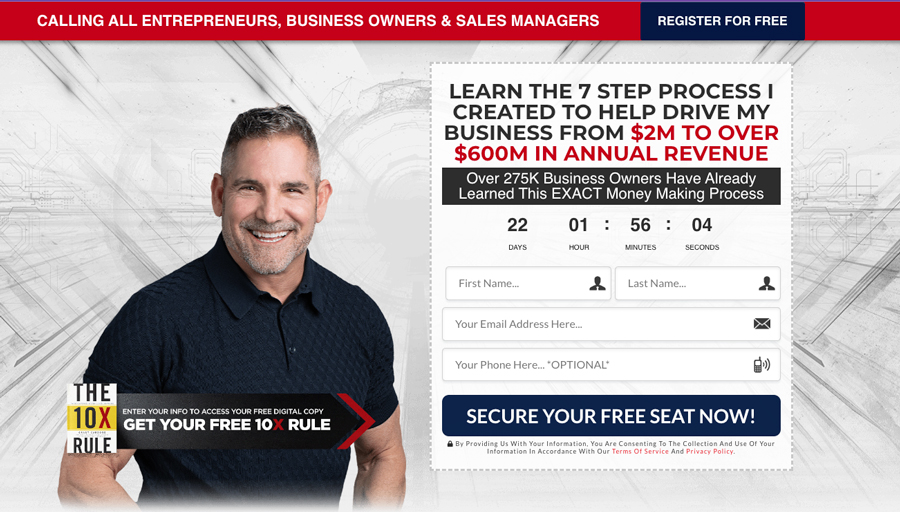Beating inflation is critical to your survival as a business owner.
According to Goldman Sachs, ⅓ of businesses had their sales fall because of record-breaking inflation.
Bankrate says inflation is the #1 concern for nearly 70% of Americans. As a business owner inflation increases your input costs or makes your customers cut back on spending. Both squeeze your margins. And the worst may be yet to come.
A survey by Goldman Sachs indicates 93% of small business owners fear a recession by year’s end. I believe we’re already in a recession.
You have 2 choices…
Option #1: Cave in and wallow in misery as inflation devours your business. Or…
Option #2: Adapt and expand.
I recommend option #2. Despite the fear, uncertainty, and media panic, economic crises are a massive opportunity if you’re brave enough to take massive action.
I’m living proof of this. The Great Recession of 2008 almost destroyed me. I was terrified, paralyzed, and drifted into depression. If it weren’t for Elena, I might have crumbled like so many other business owners that didn’t make it. She told me, “Get back in your office and figure something out.”
I spent hours re-imagining my whole business. I wrote The 10X Rule, started the 10X movement, and massively increased spending and marketing activities. The Grant Cardone you know today was born out of the devastation of 2008.
After living through five major economic contractions, I’ve created a proven strategy to keep my 16 businesses alive and well — including in an inflationary environment. Focus 100% on what you can control in your business: your ability to produce and provide value.
The 10X Owner Inflation Survival Blueprint
Step 1 — Set Massive Targets & Reverse Engineer Your Actions
As a business owner, success is your responsibility no matter what’s happening in the economy. That starts with acceptance of the situation. Accept inflation. Only then you can make an action plan.
Then, set a massive target and reverse engineer the actions you need to take to get there. Pick a target that seems great and then literally 10X it. That new number is your massive target. I guarantee you will make more money than you would have if you keep your targets “reasonable.”
If you aim for $1 million, you won’t hit it. But if you aim for $10 million, and you follow up with massive action, you’ll blow past $1 million faster than you ever thought possible. If your targets aren’t big enough, eventually you’ll give up on the massive action required to reach them.
Next, reverse engineer the actions you need to take to hit the target or you have no chance of inflation survival.
Say your massive target is $10 million per year. How much will you need to make every month, week, day, and hour to hit it?
The math works out to $833,000 per month… $209,000 per week… $30,000 per day… $2,500 per hour… or $41 a minute. Again, don’t focus on how reasonable it is. Focus on the actions.
Your first action is to make a list of all of your current products and services. Then, list out all of the resources that can generate sales. That means all of your products starting from your most expensive product and service to your lowest-cost offerings. Then, evaluate your sales team, your online store, your online marketing funnels, etc. Anything that generates revenue for you needs to be on this list.
Fourth, set income goals for each of your revenue streams based on the money math you did in the second step. Prioritize your most profitable ones (I’ll go deeper into how to do this in Step 3 of the blueprint). But for this example, let’s say you have five income streams, and your top two accounts for 80 percent of your revenue generation. That means income streams #1 and #2 need to make a combined $24,000 per day while the rest pull in the remaining $6,000.
Fifth, once you distribute your new target across your revenue streams, meet with your executives and team leaders.
Your team needs to optimize or invent new ways to reach your new 10X hourly, daily, weekly, and monthly goals. Every revenue stream needs a clearly defined revenue target and practical actions to get there. Create incentives for those who meet the new quotas and penalize those who don’t.
Remember, you’re not saving your company all on your own. And guess what? If you’re scared of inflation, your employees are terrified. They’re worried about supporting their families and keeping their job.
Help them accept, commit to the target you set, and then take the massive action needed according to the math. Start by having a frank discussion with your team leaders about the situation and the dangers. With my team, I always explore the worst-case scenario, so no matter what happens we’re always prepared.
Everybody needs to be on the same page prioritizing one thing: revenue generation. This is a fresh start for the company and everyone involved. During a crisis like crushing inflation, you can’t afford any dead weight. Anything and anyone not helping the company’s new mission will have to go.
Step 2 — Assess Your Assets and Liabilities
If you want to grow out of an economic storm, you have to make hard decisions. You have to abandon anything that will present a disadvantage to your company. This requires a detailed assessment of all your assets and liabilities.
An asset is something you control that creates cash flow or growth for the company. A liability is something that doesn’t create cash flow. They may even create a disadvantage for your company. Any liabilities need to be fixed or trashed.
Everything your company controls – properties, products, offers, customers, partnerships, and employees – can be assets or liabilities. Part of accepting the situation is realizing can’t keep things the same. In difficult times, if something’s not helping, then you have to get rid of it.
When COVID hit, I had to take action.
Within the first week of lockdowns, I fired 42 people. I didn’t want to do it. But I knew that we’d be going remote and those 42 people became liabilities.
One of my products became a liability too… a course called the Playbook to Millions. Normally I sold it for $2,900 — but when COVID hit I couldn’t get anybody to buy it. So these massive binders sat in a closet collecting dust… which made them a liability. I lowered the price to $48 and sold 40 of them the same day.
On another offer, I charged $1,500/mo with a $4000 start-up fee. The start-up fee became a major liability to closing deals with money-conscious buyers. So I told my salespeople I’d fire them on the spot if they tried to charge anyone a startup fee.
This is what you need to do. Either transform liabilities into assets or get rid of them. Period.
Cutting dead weight can entail some of the most difficult decisions employers ever have to make. But in times of crisis, you’ve got to take control for everyone’s benefit.
Step 3 — Multiply Your Most Successful Actions for Inflation Survival
The 80/20 rule says 80% of the work is done by 20% of your people. Or, 80% of your revenue comes from 20% of your products. During cash crunches like inflationary periods, you have to use this rule to your advantage.
Your top revenue-generating activities will fall into one of two categories: 1) directly generates cash flow and 2) attracts new leads/customers. This includes your core products, most popular offers, and top-performing sales and marketing activities.
Maximize whatever is already outperforming everything else. Expand your most popular line of products, try different price points, create new offers for your best products, and expand into a related service that serves your best buyers.
For example, my company produces a lot of sales over the phone. So what did we do during the COVID crisis? We increased our call volume by almost 30%. And as a result, our collection numbers were 11% higher than the national average. Identify what you do best and max it out.
This especially applies to marketing. Your marketing activities are crucial to increasing desperately needed revenue. The more people who see your business, the more they’ll buy. You can increase your marketing without increasing spending using social media.
Step 4 — Stay Focused. Stay Disciplined.
By step four, you’re already way ahead of the average business owner. At this point, a lot of owners will quit pressing their business. But inflation won’t quit. If you want to beat it, you’ll have to grow your business more consistently than inflation.
The people who thrive during difficult times are focused, committed, and consistent. You’ll need to tighten up the procedures across your company. Have daily meetings to review your results against your targets.
Train your employees every day on how to hit their targets. Encourage and enforce accountability with regular progress reports. Incentivize superior performance with bonuses or commissions. Institute a zero tolerance for underperformance or policy violations. And continue to sell acceptance of the worst-case scenario and the plan to beat it. Without it, fear and anxiety take over.
This is the blueprint I followed that helped my company grow during two of America’s most devastating economic contractions. Use it to grow your business.
And if you have any questions, comment below.
Be great,
Grant Cardone
Disclaimer: This content is intended to be used for educational and informational purposes only. Individual results may vary. You should perform your own due diligence and seek the advice from a professional to verify any information on our website or materials that you are relying upon if you choose to make an investment or business decision. Investment, real estate, and business involve great risk and there is no guarantee of performance or results.We are not attorneys, investment advisers, accountants, tax professionals or financial advisers and any of the content presented should not be taken as professional advice. We recommend seeking the advice of a financial professional before you invest, and we accept no liability whatsoever for any loss or damage you may incur.



























